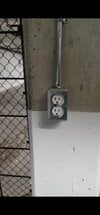eprosenx
Active Member
Hi, I own a model 3 and live in a condo that has underground parking. The only outlets that are available for charging are in the storage closet next to my parking spot. The parking itself has like 15 foot ceilings and the outlet that is setup in the closet is this exact model Leviton Porcelain Lamp Holder with Pull Chain and Outlet-R60-09726-00C - The Home Depot
So I able to ask the maintenance guys to use their ladder to run an extension cord of this kind RIDGID 25 ft. 14/3 Outdoor Extension Cord-657-143025RL6A - The Home Depot to be attached to the outlet so I could start charging the car. Now the car charges at only 9/12 amps and stays at around 102-104 volts, which is pretty low but it still charges at 3 mph. I was able to plug just the adapter directly to the car and it still only gave me 9/12 amps with the notification that an extension cord was being used. Anyway if I kept everything as is and just used to charge with the extension cord at 9 amps for constant use; would I be running into any risk of the outlet starting on fire or the cable? I thought since its only draining at 9 amps and both outlet and cords are rated at 15 amps I would be okay, but I rather get a 2nd opinion from anyone here.
Thank you
PS I don't have an option of installing any other outlets in there, everything has to stay as in the parking garage as it's not allowed by the management
So I am going to take a slightly different tact on this conversation than most have commented on so far.
Yes, 120v charging is not optimal.
Yes, plugging into a circuit with lots of connections is not optimal.
Yes, plugging into a non dedicated circuit is not optimal.
Now, with all that being said, if there is *truly* no realistic way to push for a better setup, I would take nine amps of charging over nothing. At least it will offset vampire losses.
So here is my thesis: I am making the assumption that this is a 20a circuit (generally required in a commercial building), and that all the wire is run in metal conduit, and that the garage is made of concrete walls/floors/ceilings. I am also assuming the wiring is generally of reasonable quality (the conduit is properly grounded) and the building has proper smoke detection and fire suppression systems.
If all of that is true, then I guess I am not too concerned about the dangers of using that receptacle. Likely the worst case is some connection melting (because of a bad connection) and shorting out to the conduit and blowing the breaker. The repair work would likely be just pulling new conductors in that conduit. Commercial wiring is often times a lot more resilient than residential.
I was about to say that the voltage drop described is not that horrible given that distance, though I just ran some math and it is a bit lower than I would expect (though it is possible that the panel that circuit comes off of could also be a long way from the feeding service/transformer). If the voltage drop can be completely explained simply by the wire distance calculations then I actually would not be that worried about charging a Tesla off of it. Yes, it is dissipating that energy as heat, but over more than 200 feet of conduit that is not a lot of energy as long as it is not all dissipating at a single joint or connector.
This is not like a synchronous motor which when the voltage drop it just draws more current to keep spinning at the same speed (which increases the load on the wire further). The Tesla will draw a fixed amount of amps regardless of the voltage (it is computer controlled...). If the voltage is lower, it just charges slower.
The Tesla sounds like it is backing off to 9 amps (is it giving you errors when it does this?) because it sees the voltage drop delta between when you start charging and after it runs for a minute or two. The Tesla assumes if this drop is large it is due to a loose connection which could catch fire. If it is just because of a really long wire run it can't tell the difference.
What is the voltage when you first plug into the car (after not having charged for a while) but before the car actually ramps up charging? I am curious what the unloaded circuit voltage is vs. the loaded circuit.
Btw, you are totally fighting total resistance of the entire circuit which is causing the voltage drop. Your 14 gauge extension cord is not helping. I would absolutely upgrade that to a 12 gauge extension cord (if not 10 gauge - though that is probably overkill).
I would also replace all the light bulbs on that circuit with LED bulbs. That might give you more overhead and keep you from blowing that breaker. ;-)
Can you post pictures of all the conduit and such that you have access to and the panels, etc? I am curious if there might be a relatively inexpensive way to upgrade that circuit with basically no visible impact to the building. If there is conduit all the way back to the panel you may be able to have an electrician pull more wire into the existing conduit (could be as little as a single additional wire and using a shared neutral and ground) to give you a dedicated circuit with no extra connections in it.
EV charging is very much the future, so building owners are going to have to get onboard with it. If I owned the place, I would totally be willing to spend some $$$ to get a good charging solution. It will increase resale value!
Good luck!








